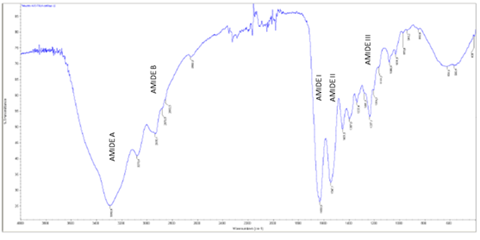Biochemical characterisation of collagen. Collagen structure by FT-IR and CD
Structural information of collagen also includes analysis of the secondary structure of the molecule:
Fourier Transform Infrared spectroscopy (FTIR) is sensitive to the chemical structures of molecules and suitable for the determination of proteins and polypeptides under different states, concentrations, and environments and is a useful tool for determining the secondary structure of proteins and polypeptides. Spectral bands in vibrational spectra are molecule specific and provide direct information about the biochemical composition. The typical FTIR collagen spectra consist of Amide I, Amide II, Amide III, Amide A, and Amide B bands (Figure 13A).
Amide I band (associated with stretching vibration of C=O) with characteristic frequencies in the range from 1600 to 1700 cm-1; Amide II band (representing N-H bending) has a normal band absorption range of 1550–1600 cm-1; Amide III (combination of C-N stretching and N-H deformation) typically found around 1232–1238 cm-1; Amide A (N-H stretching vibration typical of intermolecular hydrogen bonding) commonly observed in a range between 3000-3500 cm-1; Amide B (the asymmetrical stretch of CH2) is commonly found around 2935 cm-1. The ratio of IR absorption intensity between amide III and amide II band approximately equal to 1.0 confirms the triple helical structure of collagen (Figure 13).
Circular Dicroism (CD) spectra is used to confirm the presence of triple-helical conformations and therefore if it is in the denatured state or not. The triple-helical conformation characteristic of collagen exhibits a unique CD spectrum with a positive peak around 220 nm, a crossover at 213 nm, and a large negative peak around 197 nm. In the case of denatured collagen, the positive peak is not present and the negative peak shifts to lower wavelengths.

Figure 13. FTIR spectra of acid-soluble collagen (ASC) extracted from fish by-products.
